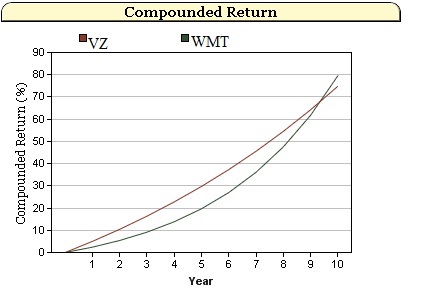It is not always easy to turn down the enticing dividend yield of a company that is paying a yield of 5% while instead opting for a yield of below 3% in the hopes that eventually your returns and yield on cost will at least break even. It’s also not obvious how long it might take for the lower yielding stock to catch up with the higher dividend yielding stock. To help answer this question I looked at two companies that offer these different alternatives: Verizon (VZ) and Wal-Mart (WMT).
| Company | Div
Yield | 1 Yr Div
Growth | 5 Yr Div
Growth | Payout Ratio |
| VZ | 5.0% | 2.9% | 3.5% | 94.0% |
| WMT | 2.4% | 20.0% | 22.0% | 30.0% |
These two companies are very clear contrasts in dividend strategy. Verizon has a much higher dividend yield, but the dividend has only been growing at a 3.5% annual rate over the past five years. Also, Verizon has a 94% payout ratio, which is dangerous for shareholders looking for strong dividends since it is taking nearly everything the company earns just to pay the dividend. This is one reason why the dividend growth rate has been so sluggish.
Although Wal-Mart has a lower yield, its prospects for dividend growth are much better. The five year dividend growth rate is solid at 22% and their payout ratio is a healthy, low figure of only 30%.
In order to compare and contrast these two stocks, I want to show readers the Yield on Cost (YOC) and how it changes over time as well as the compounded annual return due to dividends. The YOC simply measures the current annual dividend divided by the original investment in the company’s stock. I ran these calculations using our publicly available calculator called Dividend Yield And Growth. Starting with the simplified assumption that the growth rate of each dividend follows the five year growth rate, we see the following:

It takes a little over four years for the YOC for Wal-Mart to break even with the YOC for Verizon. Of course, due to compounding we see the YOC for Wal-Mart explode upward eventually. But this assumes that the company can continue its relatively high rate of dividend growth going forward. Also, if we assume that Wal-Mart’s dividend growth rate continues at this high rate, it still takes over 9 years for the compounded total return due to dividends to break even with Verizon, assuming dividends are always reinvested. It is also important to note that I do not consider any price appreciation in these calculations and compounded returns are due solely to dividends.

If we use the one year growth rate for dividends instead of the five year growth rate, the YOC will break even in year 5 and the compounded returns will break even after 10 years.
If I’m buying a dividend paying stock for the long-run, and I had to make a choice between these two companies, I would lean towards Wal-Mart and their much stronger history of robust and consistent dividend growth. They have not cut their dividend in 30 years, while Verizon has cut its dividend twice in the past 5 years. Also, I really like to see a low payout ratio so I can be confident that the company can maintain its dividend going forward. Wal-Mart has a very healthy and low payout ratio. Verizon does not.
When constructing a dividend portfolio for the long-run, it is important to keep in mind just how long it might take for a lower dividend yield to catch up with a stock that pays a higher yield. That low yield stock that you think will have stellar dividend growth rates might still not be worth putting in your portfolio until the dividend yield has risen enough to make it worthwhile.
Retirement Planning Software | Financial Planning Software